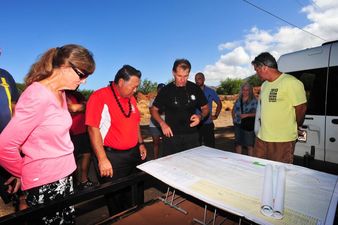West Maui GREENWAY MASTER Plan
In 2022, Maui MPO hosted 3 public community meetings about the West Maui Greenway Master Plan to provide information and receive public input. The project team conducted extensive public engagement, evaluated and prioritized route alternatives, and developed design guidance and visualizations to see that this major community asset highlights the diverse history, landscape, and culture of the region while providing safe and comfortable connections to local destinations. In October 2022, the Master Plan was presented at the Maui MPO Policy Board meeting.
The Master Plan represents a preferred route alignment, proposed trail types, and implementation strategies for the greenway.
The West Maui Greenway study area spans 25 miles from Ukumehame to Lipoa Point.
The Master Plan represents a preferred route alignment, proposed trail types, and implementation strategies for the greenway.
The West Maui Greenway study area spans 25 miles from Ukumehame to Lipoa Point.
GET INVOLVED:
- Review the West Maui Greenway Master plan
- ACTION NEEDED! The 2023 Lahaina fire tragedy has emphasized the critical importance of WMG for our community's safety and sustainability. We have a unique opportunity before us, one that may not come again in our lifetime. We must act now to make this project a reality, ensuring that we have a secure evacuation route and a pathway to a greener, more connected West Maui. Learn more >>
project segments
As outlined in the West Maui Greenway Master Plan:
1. Lipoa Point to Maui Preparatory Academy
2. Maui Preparatory Academy to Lahaina Civic Center
3. Lahaina Civic Center to Keawe Street
4. Keawe Street to Lahaina Recreation Center
5. Lahaina Recreation Center to Olowalu
6. Olowalu to Lahaina Pali Trailhead
1. Lipoa Point to Maui Preparatory Academy
2. Maui Preparatory Academy to Lahaina Civic Center
3. Lahaina Civic Center to Keawe Street
4. Keawe Street to Lahaina Recreation Center
5. Lahaina Recreation Center to Olowalu
6. Olowalu to Lahaina Pali Trailhead
DESIGN WORKSHOP - 2016
The Maui Bicycling League, County of Maui, and the State Na Ala Hele Program, in partnership with the National Park Service’s Rivers, Trails and Conservation Assistance Program hosted a design workshop February 18-19, 2016 to discuss and develop ideas for a West Maui Greenway extending from Ukumehame to Lipoa Point using existing abandoned agricultural roads wherever possible and connecting to existing trails in the area.
